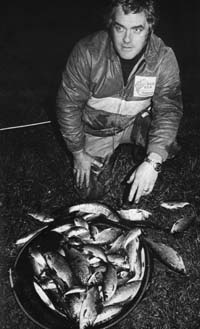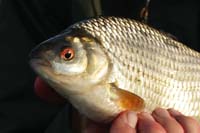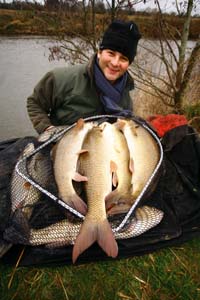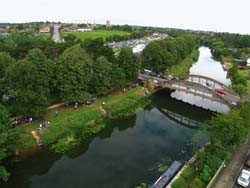Things not quite what they used to be on your favourite river? Charles Crundwell, senior technical specialist for the Midlands Environment Agency’s fisheries department, talks to the TCF magazine team…
tcf: As recently as the 1980s the water in some rivers that ran through industrial areas was so polluted that fish could not survive. What changed?
CC: The reasons are numerous and vary from river to river but some key UK developments took place over this period. The UK became less dependent on industry and manufacturing to drive our economy and this reduced the amount of pollution entering our rivers. Privatisation of the water companies in the 1980s required funded improvements to water supply and treatment infrastructure, which improved discharge quality. This process of improvements continues to this day. The privatisation of the water companies also led the way to an independent regulator to monitor and enforce pollution legislation. This regulator is now known as the Environment Agency. Alongside all this, the European Union introduced a number of directives leading directly to increased investment in water quality by the UK Government.
tcf: So what has this done to our rivers?
CC: Well, the vast majority of our water courses now contain fish, while others have seen significant changes to the fish species present as the clean-up progressed. It’s vital for anglers to understand how fish have adapted to these changes and what that means to them.
tcf: So what contributed to the so-called ‘golden age’ of river fishing, when there seemed to be fish everywhere and you could catch them all day?
 |
| The days of match anglers turning up and anticipating that everyone along a long stretch will bag up on roach have gone… |
CC: In a word, sewage! Rivers such as the Warwickshire Avon were full of it. It not only gave the river a distinctive colour, but it also contributed to a huge amount of food for fish in the form of the millions of organisms that fed off the sewage. The rivers were literally full of bloodworm and similar organisms. So any fish that could survive the occasional drop in oxygen and could eat virtually anything, did extremely well. Enter the roach, highly adapted to turbid, food-packed rivers. Ever wondered why roach seem to be the only other species that can thrive in highly stocked commercial carp waters? The same reasons explain how they did well in the rivers in the 1960-70s – they waters were turbid, full of food, and the roach will eat anything and can survive variable water quality.
tcf: So what happens to rivers as the water quality improves?
CC: The most visible sign is improvements in water clarity as the amount of organic suspended solids is reduced. This leads to increased plant growth, which in turn traps sediment, further improving water clarity. This whole cleaning up process reduces the amount of food available for the fish to eat, but this loss is replaced by a far larger range of food organisms living in the river (increased biodiversity). This is a good thing as it creates more habitats or niches for other fish species to use and thrive.
tcf: So anglers have a wider range of fish to go at?
CC: Species like chub, dace and barbel could suddenly survive and reproduce in the cleaner water. This process continues today as rivers that only held three or four different fish species in the 1960s now routinely hold up to 15. Count them – roach, chub, dace, barbel, carp, tench, bream, bleak, rudd, ruffe, gudgeon, grayling, pike, perch, zander… And the list continues to grow. Surely this is better for the average pleasure angler?
tcf: So if there’s such diversity why do anglers complain about the fishing on venues like the Warks Avon?
CC: There is a downside to water quality and clarity improvements for anglers. Everything a fish does is related to three things: feeding, avoiding predation or reproduction. Improved water clarity can make feeding and avoiding predation harder, but on the plus side conditions for reproduction (clean gravel or plant growth) are improved. In turbid water a fish can risk feeding all the time as it is down to chance that it will come into contact with and be eaten by a predator. To improve their chances of survival in high clarity water, fish change their behaviour to balance feeding against predation risk. These changes include feeding in the morning and evening or during the night, and forming tight shoals to reduce any one individual’s chance of been attacked. They also hide in weed during the day and use features to aid protection like bridges, moored boats, undercut banks and weed. So improved water quality improves the angling experience in terms of the range of species you can catch, but you will have to work harder to catch them. To be successful anglers to adapt, just like the fish have.
tcf: Are there any other effects of this cleaner, clearer water?
CC: Fish also adapt unknowingly in another way to improved water quality and that is in their life strategy. In turbid, food rich water it is best to live fast, die young. In clear water, learned behaviour on how to feed but avoid predation is rewarded in living longer and attaining a greater size. This is further rewarded in that the bigger you are, the less likely you are to be predated on and thus you can eat safely for longer.
tcf: So there are more specimen fish about?
CC: Exactly. Welcome to the specimen water and headlines such as ‘Barbel record smashed again’. This is great if you wish to specialise in a particular species; just think how many specimen groups have formed in recent years. But not so good if you want to spend a couple of hours, in the middle of the day, in the summer, float fishing a peg chosen not by in-river habitat features but more by the closeness of the car park, toilet, butty wagon, or by the draw bag. If you are interested in fishing for specimens you have never had it so good. If however you are interested in a couple of hours, occasionally when the opportunity arises, I imagine you have left the river behind and are sitting on the banks of a commercial fishery that has recreated the turbid, food rich waters that our rivers used to be.
 |
| There are now fewer roach around, but the cleverer ones have the opportunity to grow bigger. |
tcf: So why is the fishing never consistent in a river? One year the river is full of dace and five years later a dace is almost unheard of.
CC: In a nutshell, rivers are always changing and fish stocks adapt to these subtle changes. Or in the case of the summer 2007 floods, not-so-subtle changes! The changes in fishing between months are primarily linked to fish migration in relation to reproduction. That is why weir pools are hotspots for chub, dace and barbel just prior to the end of the season. These fish species spawn on the gravel deposited and kept clean by the flow below weirs. While weed spawners (roach, bream, pike etc) form large shoals at suitable sites, often leaving large sections of the river empty of particular species. Bream will happily travel 15km to spawn, while dace will travel even further. Protecting shoaled fish prior to spawning is one of the key reasons for the close season on rivers.
tcf: That doesn’t really explain how you can bag up one day and struggle for a bite the next though…
CC: Day to day variations are often related to short feeding migrations. Improved water clarity reduces the amount and distribution of food available, so fish must move to particular spots to feed before exhausting the food supply and moving on again. If you’re in a large shoal to avoid predation you will exhaust the food source even quicker and need to move on more regularly. An angler can either try and predict where the fish might move to (watercraft) or artificially place bait in the water (pre-bait) to encourage or hold the fish already present. Specimen hunters on our rivers have mastered this technique to consistently catch.
tcf: Things sound pretty grim if you’re a match angler then…
 |
| Species like barbel and chub thrive in the cleaner water of our rivers. |
CC: Match anglers don’t have this luxury as they only get to know their pegs a short while before the competition. Some match venues are getting less and less angling pressure and this is a vicious cycle, as the less food that goes in, the more fish have to migrate further and in larger shoals to exist. So you end up with hotspots, while others struggle to get a bite. This doesn’t mean the river is short of fish, just that they are poorly distributed.
tcf: Your own surveys back this up?
CC: We know this to be true from our surveying of large lowland rivers using hydroacoustics. Hydroacoustics can be likened to how a bat identifies its prey by sending out acoustic sounds and then listen for the returning echoes when they strike an object. We do the same but underwater, listening for returning echoes from the swim bladder of fish. These surveys are carried out in the dead of night, when fish feel the safest and spread themselves in the water column to feed. Rivers that anglers say are empty of fish can literally be ‘fish soup’ during the night.
tcf: So what causes a river to change from, for instance, a roach dominated fishery to one where chub are the main species?
CC: This is all related to how long each fish species lives and the balance between species competing for a finite food resource. Every fish species has a different life expectancy. Gudgeon will be lucky to get to four years of age, while a barbel may make it to its thirtieth birthday. That is one of the reasons why anglers name their specimen fish. They are quite literally old friends. It’s important to remember that not all years are equally good for spawning and success can vary by fish species. To spread the risk and reduce competition, all fish spawn at slightly different times, thus the reason for the long close season. Dace are often first (March), while tench and carp may hang on into July or not at all if it is a cold summer. This means that in each year there are winners and losers, or in scientific speak, the winners in any year are said to have a good year class strength (YCS).
tcf: So the fish literally die out?
CC: Roach live on average for five to seven years while chub can happily survive for 10 to 15 years. To maintain their dominance in a fishery, roach must have a good YCS every five to seven years, while chub need only be successful every 10-15 years. For the hapless gudgeon it is as regular as every three years and this is why gudgeon can seem to, and literally do, disappear from fisheries only to return many years later. All ecosystems only have a limited amount of food, so if you get a very good year class of a particular species they get most of the food resource so dominate the fishery. For example, chub dominated match catches on the Warwickshire Avon for years before that population finally died of old age. If there is not another class of chub following on behind, chub disappear almost overnight, and this is exactly what happened. The fishery does, however, quickly adapt to the newly available food resource and another species begins to dominate, in this case barbel. But anglers on the Warks Avon were slower to adapt to this. This is a natural process and is what makes river fishing challenging and constantly changing.
tcf: What about the effect of predators?
CC: A common response to naturally changing fish populations is that fish predators are wiping out all our fish. This is just not true. Predators generally make up 10 per cent of the total biomass of a fishery by weight and are completely dependent of prey fish, the other 90 per cent, for their survival. If you have a lot of predators you must have a lot of prey fish. So anglers should welcome predators and learn to adapt as anglers. The biggest impact predators have on fish is not eating them, but making the prey fish change their behaviour to avoid being eaten. Their survival strategies are the same as mentioned earlier (shoaling, feeding at night, using features for protection). If you are going to succeed on a water with a healthy stock of predators you either need to locate the shoals, fish in low light conditions, fish during high turbid water conditions (floods) or target specimen fish that are not troubled by predators because of their size.
tcf: There are plenty of waters we know where as soon as you get silver fish on your peg, the swim seems to be full of pike and every decent fish you hook gets grabbed…
CC: If you add groundbait and loosefeed as anglers do, you are increasing turbidity and the food available. Now a shoal of fish is prepared to take the risk to feed over the chances of being eaten, even in the middle of the day. The problem for you as an angler is that you are literally making the perfect conditions for feeding predators, so you keep getting predatory strikes. Not surprising really because every time you catch a fish you are artificially dragging it away from its protective shoal and the predator will attack this ‘weakened’ individual. The result is you think the water is over-run by predators.
tcf: So any culling of predators is a mistake…
CC: As I said earlier, predators can only survive if there are enough prey fish to support them and I would not recommend culling any predators. It just upsets the natural balance. But if you feel you must, there are some basic principles to observe, particularly for pike. Take the smallest and leave the largest. Large pike are not fussy and will happily eat another pike. Large pike are also territorial and will displace smaller pike. These displaced pike will either find an empty territory, starve or be eaten by the next pike down the river. Displacement is a key principle as it shows that culling will only have short term benefit, as new pike will quickly move in to replace the fish culled.
tcf: What about zander – they are not part of the ‘natural balance’ in the UK?
CC: No, because they are not native. But we have to accept that they are here now and removal is not possible from our rivers. So we have to live with them, but please don’t illegally move them to waters that don’t contain them, even if you don’t think they will escape from their new home. The spread of zander in the UK is almost entirely down to man, rather than natural processes. Zander are highly adapted predators and hunt in packs – the perfectly designed fish predator. They do, however, have one limitation, a small mouth, meaning that they can only generally swallow fish of less than a pound (unfortunately the ideal size for the pleasure angler). Their dependence on small fish has the added consequence that large fish are safe from predation and rivers that have zander are often now noted for their specimen fish. Culling zander will make no difference and as they don’t particularly prey on themselves like pike; leaving only the larger ones is unlikely to significantly reduce the numbers of smaller zander. I would advise you just leave them alone. On the continent, zander are highly prized as a food fish and man acts as the ultimate predator, but the fish removed are quickly replaced by the next generation and the process repeats itself.
tcf: So what’s your overall advice on river fishing to tcf readers?
CC: In conclusion, rivers are great. They offer challenging and ever-changing fishing experiences. Quite rightly, the improvements in water quality are here to stay and have benefited all wildlife. So anglers need to adapt, changing their approach river fishing and thinking more as a predator, as ultimately that is all that fisherman are, a predator that chooses to return their catch at the end of the day. If you blank or have a poor day, you either mis-read the water conditions or the fish weren’t feeding. Only starving fish need to feed all the time. In the natural conditions of a river, fish can cease feeding for long periods. It does not mean that the fish aren’t there. Isn’t trying to outwit a wild creature where the true enjoyment and skill of angling comes from anyway?
 |
| Charles Crundwell |
Name: Charles Crundwell
Age: 38
Hometown: Chepstow
Occupation: Senior Technical Specialist In Fisheries, Environment Agency Midlands Region
Qualifications: MSc in Fisheries Management from Hull International Fisheries Institute, University of Hull. He worked on fish farms, river keepering and shell fish farms before joining the National Rivers Authority, tracking salmon on the River Dee, North Wales (1992) and has been in fisheries ever since






